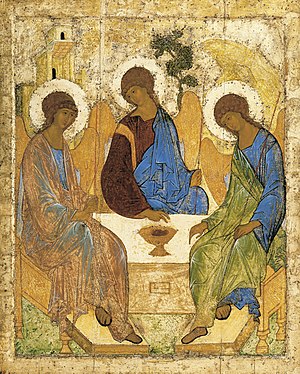Trinity (Andrei Rublev)
| The Trinity | |
|---|---|
 |
|
| Artist | Andrei Rublyov |
| Year | 1411 or 1425-27 |
| Medium | Tempera |
| Dimensions | 142 cm × 114 cm (56 in × 45 in) |
| Location | Tretyakov Gallery, Moscow |
The Trinity (Russian: Троица, tr. Troitsa, also called The Hospitality of Abraham) is an icon created by Russian painter Andrei Rublyov in the 15th century. It is his most famous work, and the most famous of all Russian icons, regarded as one of the highest achievements of Russian art. Scholars believe that is it one of only two works of art (the second being the Dormition Cathedral frescoes in Vladimir) that can be attributed to Rublyov with any sort of certainty.
The Trinity depicts the three angels who visited Abraham at the Oak of Mamre (Genesis 18:1–8), but the painting is full of symbolism and is interpreted as an icon of the Holy Trinity. At the times of Andrei Rublëv the Holy Trinity was the embodiment of spiritual unity, peace, harmony, mutual love and humility. The icon was commissioned to honour the saint Sergius of Radonezh of the Trinity Lavra of St. Sergius near Moscow (now in the town of Sergiyev Posad). Little is known about The Trinity's history, art historians can only make suggestions based on few known facts. Even the authorship of Rublev is questioned sometimes. Various authors suggest different dates, such as 1408-1425, 1422-1423 or 1420-1427. The official version states 1411 or 1425-27. The Trinity is currently held in the Tretyakov Gallery in Moscow.
The Trinity was painted on a vertically aligned board. It depicts three angels sitting at a table. On the table, there is a cup containing the head of a calf. In the background, Rublev painted a house (supposedly Abraham's house), a tree (the Oak of Mamre), and a mountain (Mount Moriah). The figures of angels are arranged so that the lines of their bodies form a full circle. The middle angel and the one on the left bless the cup with a hand gesture. There is no action or movement in the painting. The figures gaze into eternity in the state of motionless contemplation. There are sealed traces of nails from the icon's riza (metal protective cover) on the margins, halos and around the cup.
...
Wikipedia
